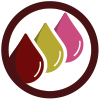Posted by Brent Modzelewski on July 30, 2021
How to Read a Wine Label
Reading an American Wine Label
The American Wine Label
If understanding wine wasn't hard enough, bottle labels contribute to the confusion among the everyday consumer. Wine labels can vary quite a bit from country to country, this post will focus on reading wine labels from the United States of America. Much of these tips to reading a wine label will be similar to other New World Wines, such as wines from South America, Australia, etc. In the United States, there are a few items that are required by law to be included on the label. These include the wine producer name/address, the brand name, the type of wine, the volume of the bottle, the ABV (Alcohol by Volume) and the sulfites. The front label is where the vineyard marketing team is trying to grab your attention with the name, the artwork and the colors. Be sure to look at the rear label as well, the information you need about the wine is contained within both labels.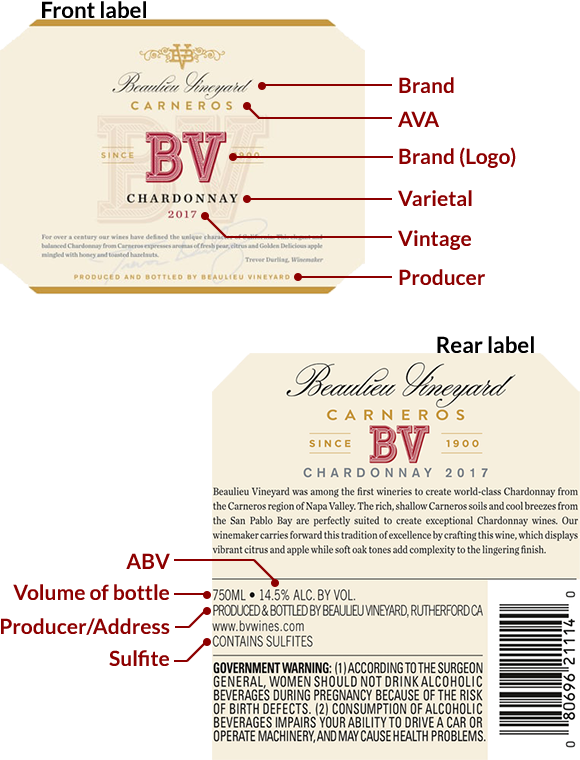
What to look for
Critical items to look for on the label are Varietal or blend, Brand name, AVA (American Viticultural Area) and Vintage. I don't concern myself too much with ABV (Alcohol by Volume), since most wine is 12-15% and not as important as the other elements in my opinion. The varietal is important because you need to know what aroma/flavor profile to expect. Next is the combination of the varietal with the brand name. After you become familiar with various brands, you will come to know which brands create wines that are more complex than others. The AVA becomes important as it "shifts" the standard aroma/flavor profile of a varietal and introduces other elements like acidity and minerality. Lastly, is the vintage, because each year's weather alters the grapes producing wine that is different each year. Not all wines will list a vintage year. Only wines that are composed of grapes harvested from a single year (at least 95% from that year) will indicate a vintage on the label.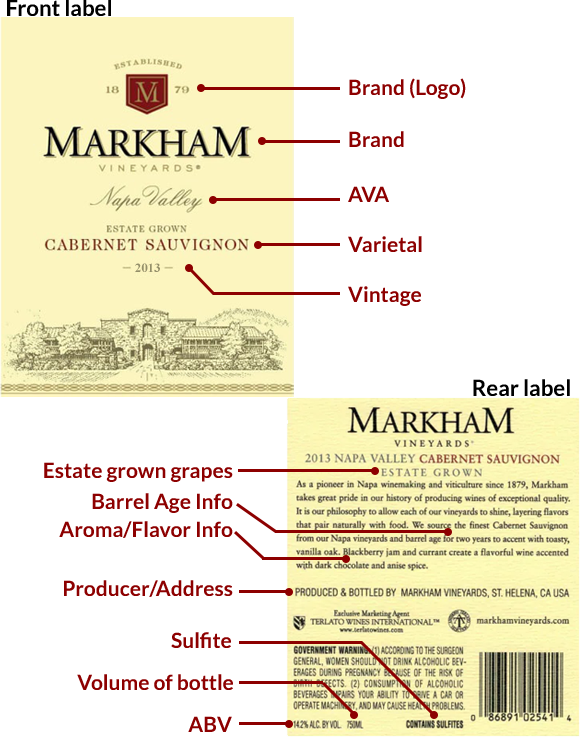
Markem Example
The rear of the Markem label above gives important information about the wine. First, you will notice that it says Estate Grown so you know the grapes are grown on the vineyards property, meaning they are not sourced from elsewhere. Second, you will notice the barrel aging and the vanilla oak that comes from that. Third, you will notice the aromas and flavors of blackberry jam, currant, dark chocolate and spice. Not all rear labels have this amount of information, but I wish they did. Now go back and take another look at the BV rear label. Can you tell if the wine was oak aged or what the aromas/flavors will be?Varietal
The varietal is the simplest item to identify on the label and also the easiest to use for beginning wine drinkers. Wines can be listed as a single varietal as long as the wine contains at least 75% of that varietal (Europe requires 85%). For example, if a wine has 75% Cabernet Sauvignon, 15% Merlot, 5% Cabernet Franc and 5% Petite Verdot, the wine can be labeled as a Cabernet Sauvignon. It is not necessary to divulge the percentage breakdown of each varietal on the label. However, wine producers are not allowed to list the percentage of one grape without listing the percentages of all the grapes. So if the wine label lists the % of Cabernet Sauvignon, it must then list all of the varietals and their percentages. See the Pine Ridge example below. Since two varietals were put on the front label, the rear label must show the percentages of each. For this wine Pine Ridge could have labeled it as a Chenin Blanc and make no mention of the Viognier since the percentage of Chenin Blanc is over the 75% threshold. This particular bottle is a non-vintage wine. Pine Ridge does have vintages of this wine and if you compare multiple vintages you will see that the percentage of Chenin Blanc and Viognier varies from year to year.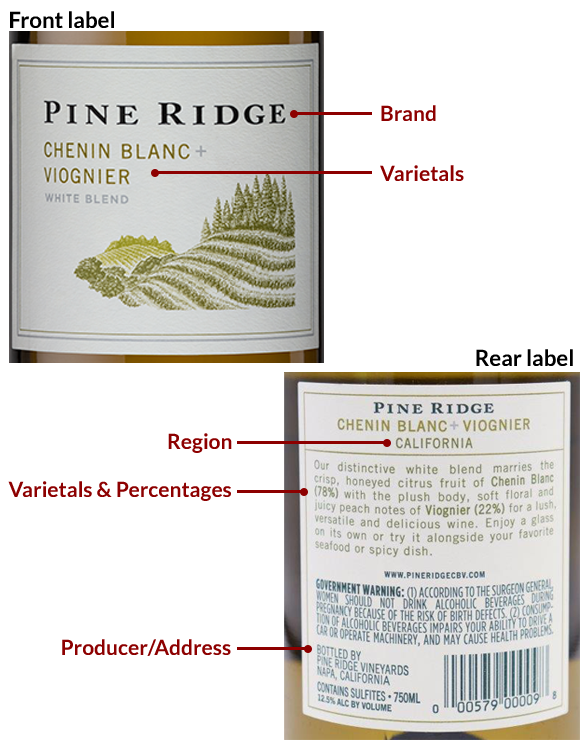
Location, location, location
As you drink more wine from different vineyards, you will learn which brand names you prefer. You will also be able to identify price points based on brand names as well. As the price point increases, so does the quality and complexity of the wine produced by that wine maker. Looking past the simplicity of identifying the varietal and the brand name, comes the AVA, which is the area from which the grapes are grown. It takes a little more experience with wine to identify how an AVA effects the aroma/flavor profile of wine. Usually, if you know a brand name, that brand name is often from the same AVA. But AVA comes into importance when you are looking at a varietal of a brand you don't know and want to select a wine from an AVA that you like. In the United States there are over 200 AVAs, so it is not trivial to know all of the AVAs and how they affect the wine profile.
Wine Nerd Fact Information
Single Varietal Fuzzy Logic
Even if the front label says a single varietal, that does not mean it is a single varietal wine. Remember, that the wine only needs to be 75% in the US to be labeled as a single varietal. For example, if a Cabernet Sauvignon label does not list the percentage of Cabernet Sauvignon, you should not assume it is 100%. It is likely a blend. The producer chose not to list any of the varietal percentages, so it appears to the consumer like it is a 100% Cabernet Sauvignon. If the wine was 100% the wine producer would likely put that on the bottle label. This doesn't mean the vineyards, wineries and producers are out to fool the consumer. They are not trying to mislead the consumer, in fact, they are trying to help the consumer. How so?, you ask. Each year the grapes are different, which makes it extremely challenging for the wine maker to produce the same wine year over year that has precisely the same profile...flavor, aroma, acidity, tannins, intensity, etc. To combat what Mother Nature throws at the vineyard, the wine maker uses Poetic License to blend some grapes together to achieve the same wine year over year, or to have a varietal taste like the varietal is supposed to taste like. Hence, a wine blend. But it would be confusing to the average consumer if they saw 5 or 6 different varietals on a label. Most would not know what that would taste like. And remember, the wine make is doing this blend so it tastes and smells like a specific varietal. Therefore listing multiple varietals would, in fact, mislead the consumer in this case. Which is why the wine producers sometimes list just one varietal on the label and not any of the percentages. Think about it a different way. When you go into your favorite coffee shop and order an Largo iced unsweetened half-caf double-shot organic vanilla frappuccino with light-whipped-soy foam you don't know the percentages of all of the ingredients, but you know it tastes the same each time you go to the same coffee shop. In this case the only label is the mispelling of your name.Wine2Oh Recommended Wine
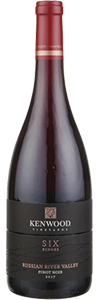
Kenwood Vineyards is an underrated vineyard and sadly have their wine placed on low shelves in wine shops and groceries stores. The good news for you is you can get a very good bottle of wine at a low price. The Six Ridges collection is their mid-tier offering and is a fantastic value.
Kenwood Six Ridges
Pinot Noir
From the Russian River Valley AVA, this is a 100% Pinot Noir that has seen at least 9 months in French Oak, which adds nice vanilla hints to the red fruit and balanced flavors of this Pinot Noir. $30.
Disclaimers: We are not affiliated, sponsored or funded for this blog post. It is purely for the love of wine.
Copyright Great Meadow Products, LLC. All rights reserved.
